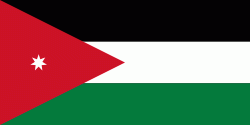Mafraq Governorate (Al Mafraq)
Mafraq (محافظة المفرق Muhāfaẓat al-Mafraq, local dialects Mafrag or Mafra' ) is one of the governorates of Jordan, located to the north-east of Amman, capital of Jordan. It has a population of 287,300 (2010 estimate) making up 4.5% of Jordan's population. Its capital is Mafraq, which is known for its military bases.
Many Roman and Byzantine sites have been found throughout the governorate, most notably churches dating to the third century AD; believed to be two of the oldest purpose built churches in Christianity: and Roman water dams in Jawa, Ruwaished, and the city of Mafraq. The Jawa Dam is the oldest known dam in the world, dating back to 3000 B.C. Mafraq city also contains a Roman fort.
During the British mandate period, Mafraq housed military facilities which are still in use today. The fifth division of the Jordanian Army is stationed in Mafraq.
Many Roman and Byzantine sites have been found throughout the governorate, most notably churches dating to the third century AD; believed to be two of the oldest purpose built churches in Christianity: and Roman water dams in Jawa, Ruwaished, and the city of Mafraq. The Jawa Dam is the oldest known dam in the world, dating back to 3000 B.C. Mafraq city also contains a Roman fort.
During the British mandate period, Mafraq housed military facilities which are still in use today. The fifth division of the Jordanian Army is stationed in Mafraq.
Map - Mafraq Governorate (Al Mafraq)
Map
Country - Jordan
 |
 |
| Flag of Jordan | |
Modern-day Jordan has been inhabited by humans since the Paleolithic period. Three stable kingdoms emerged there at the end of the Bronze Age: Ammon, Moab and Edom. In the third century BC, the Arab Nabataeans established their Kingdom with Petra as the capital. Later rulers of the Transjordan region include the Assyrian, Babylonian, Roman, Byzantine, Rashidun, Umayyad, Abbasid, and the Ottoman empires. After the Great Arab Revolt against the Ottomans in 1916 during World War I, the Greater Syria region was partitioned by Britain and France. The Emirate of Transjordan was established in 1921 by the Hashemite, then Emir, Abdullah I, and the emirate became a British protectorate. In 1946, Jordan gained independence and became officially known in Arabic as the Hashemite Kingdom of Jordan. The country captured the West Bank during the 1948 Arab–Israeli War and annexed it until it was lost to Israel in 1967. Jordan renounced its claim to the territory in 1988, and became the second Arab state to sign a peace treaty with Israel in 1994.
Currency / Language
| ISO | Currency | Symbol | Significant figures |
|---|---|---|---|
| JOD | Jordanian dinar | دا | 3 |
| ISO | Language |
|---|---|
| AR | Arabic language |
| EN | English language |















